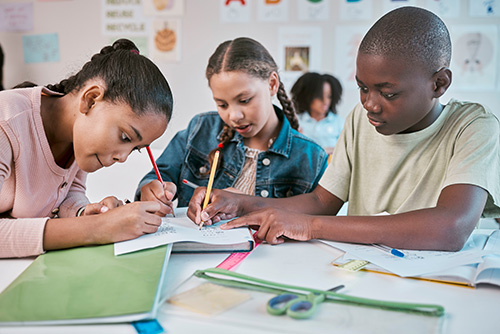Understanding Special Student Populations: Educational Impact and Strategies for Success
Wrap Up
 In this module, you learned about four areas in which educators commonly encounter student differences: culture, language, exceptionality, and socioeconomic status. You learned, too, that the perceptions teachers bring into the classroom can be shaped by their background knowledge and life experiences. Those perceptions can also be based on stereotypes, which might be inaccurate. Wherever they come from, perceptions influence how educators view their students and their students’ families. But when educators are aware of this tendency and take the time to understand their students better, they are able to respond to them more objectively. Moreover, educators need to understand how their perceptions can influence their expectations for their students and, subsequently, how they teach. For this reason, in addition to getting to know their students, educators should use a range of instructional strategies and supports when working with a diverse classroom of students. Educators can begin by creating a strong instructional foundation by using Universal Design for Learning, differentiated instruction, explicit instruction, and evidence-based practices. Then they can incorporate additional supports as needed to help special student populations. The list below provides examples of such supports.
In this module, you learned about four areas in which educators commonly encounter student differences: culture, language, exceptionality, and socioeconomic status. You learned, too, that the perceptions teachers bring into the classroom can be shaped by their background knowledge and life experiences. Those perceptions can also be based on stereotypes, which might be inaccurate. Wherever they come from, perceptions influence how educators view their students and their students’ families. But when educators are aware of this tendency and take the time to understand their students better, they are able to respond to them more objectively. Moreover, educators need to understand how their perceptions can influence their expectations for their students and, subsequently, how they teach. For this reason, in addition to getting to know their students, educators should use a range of instructional strategies and supports when working with a diverse classroom of students. Educators can begin by creating a strong instructional foundation by using Universal Design for Learning, differentiated instruction, explicit instruction, and evidence-based practices. Then they can incorporate additional supports as needed to help special student populations. The list below provides examples of such supports.
| Student differences | What Educators Can Do |
| Cultural |
Instruction might be confusing to students if their experiences or background knowledge are different from or inconsistent with those of their teacher. To support students, educators can:
|
| Linguistic |
Because mastering academic content might be difficult for ELs, educators can support them by:
|
| Exceptionalities |
To ensure that students with disabilities are accepted, valued, and included in the classroom—and to support their academic success—educators can:
|
| Socioeconomic |
Because students from low-SES households might encounter challenges that affect their learning, educators can support these students by:
|
In this audio, Lanette Waddell, former director of Teaching and Learning in Urban Schools (TLUS), suggests ways that teachers can get to know their students better (time: 2:56).

Lanette Waddell, PhD
Former Assistant Professor, Former TLUS Director
Vanderbilt University
Transcript: Lanette Waddell, PhD
The number one thing that’s important in any school is to know your students in multiple ways. You have to know who your students are. You have to know the families. You have to know their communities. And you have to be able to look at it not through just your lens but look at it from their lens and look at how it impacts why they do things, and not just immediately assume that what they’re doing is wrong or negative or rude or disrespectful, though that can happen. But how you can interact with it in a way, to talk to them about it, help you see it from their point of view, and help them to see how acting in a different way helps with teaching and learning in the school. I talk about knowing students academically, socially, and personally. You do need to know their academic skills or academic strengths and weaknesses in order to prepare the curriculum that you’re going to teach. But you also need to know how do they interact with others? How do they interact with you? How do they interact with principals, parents, families, community? How do they do with other people? And then also, personally, what are their personal strengths and weaknesses? What do they personally like and dislike? What do they think about school? What do they think about their home life? And all of those things are super important to understand. It’s so important, especially since we know that most teachers are middle-class. Regardless of race, being middle class versus being poor is different. And we bring that subconsciously into our teaching, and we expect students to want to be that way. And when they’re not, we tend to see that as negative instead of seeing it as different. So knowing who your kids are and being able to compare that to how you think about the way you want students to be could help you be more open to how they behave, what they do, how they respond and react to things. And it will allow you to think more about how you then respond to what they do and what they say, and it would probably create a much stronger classroom if you are able to do that. Your goal as a teacher is to think about what are the opportunities I provide to get to know my students? Do I have multiple ways to know who they are, to see them outside of the classroom, to talk to their parents, to talk to them at lunchtime, or talk to them in the hallway, to get to know who they are in a way that goes beyond the teaching realm? And it’s difficult. It’s much easier in elementary school when you have 25 kids all day. You can get to know them within a month, get to know a little bit about all of them, and get to know them all well probably by Christmas. But in middle schools and high schools, it’s much more deliberate on the part of the teacher to go out of their way. We encourage our teachers to join clubs, to be coaches, to even go to community sporting events where the kids are playing, to visit activities that are happening on the weekends. You get to see the kids in a different environment. You get to see them interacting with parents. It takes time, but the end result is worth it. It’s just that you have to persevere and put yourself in a situation where you can get to see all these things happening.
Revisiting Initial Thoughts
Think back to your initial responses to the following questions. After working through the resources in this module, do you still agree with your Initial Thoughts? If not, what aspects of your answers would you change?